Philadelphia Phillies
The Philadelphia Phillies are an American professional baseball team based in Philadelphia, Pennsylvania. They compete in Major League Baseball (MLB) as a member of the National League (NL) East division. Since 2004, the team's home stadium has been Citizens Bank Park, located in South Philadelphia. The Phillies are the oldest continuous one-name, one-city franchise in American professional sports.
| Philadelphia Phillies | |||||
|---|---|---|---|---|---|
| Established in 1883 | |||||
| Based in Philadelphia since 1883 | |||||
| |||||
| Major league affiliations | |||||
| |||||
| Current uniform | |||||
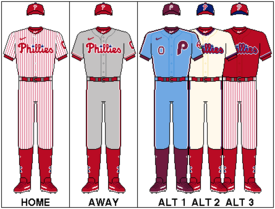 | |||||
| Retired numbers | |||||
| Colors | |||||
| Name | |||||
| Other nicknames | |||||
| Ballpark | |||||
| |||||
| Major league titles | |||||
| World Series titles (2) | |||||
| NL Pennants (7) | |||||
| East Division titles (11) | |||||
| Wild card berths (0) | None | ||||
| Front office | |||||
| Principal owner(s) | Phillies limited partnership (John S. Middleton, managing partner)[5] | ||||
| Manager | Joe Girardi | ||||
| General manager | Matt Klentak | ||||
| President of baseball operations | Andy MacPhail | ||||
The Phillies have won two World Series championships (against the Kansas City Royals in 1980 and the Tampa Bay Rays in 2008) and seven National League pennants, the first of which came in 1915. Since the first modern World Series was played in 1903, the Phillies played 77 consecutive seasons (and 97 seasons from the club's establishment) before they won their first World Series—longer than any of the other 16 teams that made up the major leagues for the first half of the 20th century. They are one of the more successful franchises since the start of the Divisional Era in Major League Baseball. The Phillies have won 11 division titles, including five consecutive division titles from 2007 to 2011; these are ranked sixth among all teams and fourth in the National League. Hall of Fame third baseman Mike Schmidt is widely considered the franchise's greatest player of all time.[6]
The franchise was founded in Philadelphia in 1883, replacing the team from Worcester, Massachusetts, in the National League. The team has played at several stadiums in the city, beginning with Recreation Park and continuing at Baker Bowl; Shibe Park, which was later renamed Connie Mack Stadium in honor of the longtime Philadelphia Athletics manager; Veterans Stadium, and now Citizens Bank Park.
The team's spring training facilities are located in Clearwater, Florida, where its Class-A minor league affiliate Clearwater Threshers plays at Spectrum Field. Other Class-A affiliates are the Lakewood BlueClaws, who play in Lakewood, New Jersey, and the Williamsport Crosscutters, who play in Williamsport, Pennsylvania. The Phillies' Double-A affiliate is the Reading Fightin Phils, which play in Reading, Pennsylvania. The Triple-A affiliate is the Lehigh Valley IronPigs, playing in Allentown, Pennsylvania.
From 1883–2019, the Phillies' overall win-loss record is 9825–11000 (.472).[7]
History
Philadelphia Quakers (1883–1889)
In 1883, sporting goods manufacturer Al Reach (a pioneering professional baseball player) and attorney John Rogers won an expansion National League franchise for Philadelphia, one of what is now known as the "Classic Eight" of the National League. They were awarded a spot in the league to replace the Worcester Brown Stockings, a franchise that had folded in 1882. The new team was nicknamed the "Quakers", and immediately compiled a .173 winning percentage, which is still the worst in franchise history. Although many sources (including the Phillies themselves) claim that Reach and Rogers bought the Brown Stockings and moved them to Philadelphia, all available evidence suggests this is not the case. Significantly, no players from Worcester[8] ended up with the 1883 Quakers.[9]
In 1884, Harry Wright, the former manager of baseball's first openly professional team, the Cincinnati Red Stockings, was recruited as a manager in hopes of reversing the team's fortunes. Also in 1884, the team changed its name to the "Philadelphians", as it was common for baseball teams in that era to be named after their cities (for instance, the "Bostons" and "New Yorks"). However, as "Philadelphians" was somewhat hard to fit in newspaper headlines, some writers still continued to call them the "Quakers" while others began shortening the name to "Phillies."[10]
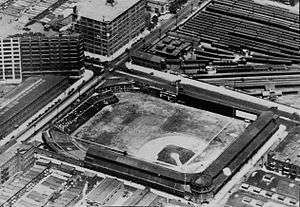
In 1887, the team began to play at the newly constructed Philadelphia Base Ball Grounds, later renamed National League Park. The stadium would eventually become known as Baker Bowl. Despite a general improvement from their dismal beginnings, they never seriously contended for the title.
Becoming the Phillies (1890–1917)
The nickname "Phillies" first appeared in the Philadelphia Inquirer for April 3, 1883, in the paper's coverage of an exhibition game by the new National League club. At some point in the 1880s, the team accepted the shorter nickname "Phillies" as an official nickname. "Quakers" continued to be used interchangeably with "Phillies" until 1890, when the team officially became known as the "Phillies". This name is one of the longest continually used nicknames in professional sports by a team in the same city.[11]
The franchise's standout players in the era were Billy Hamilton, Sam Thompson, and Ed Delahanty, who in 1896 set the major-league record (since tied by several others) with four home runs in a single game. Due to growing disagreements about the direction of the team, Reach sold his interest to Rogers in 1899.[10]
With the birth of the more lucrative American League (AL) in 1901, the Phillies saw many of their better players defect to the upstart, including a number of players who ended up playing for their crosstown rivals, the Athletics, owned by former Phillies minority owner Benjamin Shibe. While their former teammates would thrive (the AL's first five batting champions were former Phillies), the remaining squad fared dismally, finishing 46 games out of first place in 1902—the first of three straight years finishing either seventh or eighth.
To add tragedy to folly, a balcony collapsed during a game at the Baker Bowl in 1903, killing 12 and injuring hundreds. Rogers was forced to sell the Phillies to avoid being ruined by an avalanche of lawsuits.[10] In 1904 the team finished with a record of 52–100, making them the first team in franchise history to have lost 100 games.

The Phillies won their first pennant in 1915 thanks to the pitching of Grover Cleveland Alexander and the batting prowess of Gavvy Cravath, who set the major-league single-season record for home runs with 24. They finished the season with a record of 90–62, seven games ahead of the Boston Braves. The Philles went up against the Boston Red Sox in the World Series, opening the series at home with a victory. The Phillies struggled against a strong Red Sox pitching lineup and surrendered the next four games, losing the series four games to one.
The team continued to dominate the National League in 1916 but fell short of a capturing a second consecutive pennant. The team finished two and a half games out of first place with a record of 91–62. Alexander won his second consecutive triple crown and posted 16 shutouts, tying the single season major league record.
In 1917 Alexander had been traded when owner William Baker refused to increase his salary. Baker was known for running the Phillies very cheaply; for instance, during much of his tenure, there was only one scout in the entire organization. The Phillies finished the 1917 season in second place with a record of 87–65, ten games behind the New York Giants.
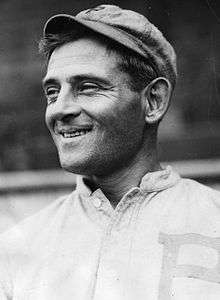
Unsuccessful years (1918–1948)
The effect of the Alexander trade was immediate. In 1918, only three years after winning the pennant, the Phillies finished sixth, 13 games under .500. It was the start of one of the longest streaks of futility in baseball history. From 1918 to 1948, the Phillies had only one winning record, which came in 1932. The team finished no higher than sixth twice, and were never a serious factor past June. During this stretch, they finished eighth (last place) a total of 17 times and seventh seven times. This saddled the franchise with a reputation for failure that dogged it for many years. The team's primary stars during the 1920s and 1930s were outfielders Cy Williams, Lefty O'Doul, and Chuck Klein, who won the Triple Crown in 1933.
Baker died in 1930. He left half his estate to his wife and the other half to longtime team secretary Mae Mallen. Five years earlier, Mallen had married leather goods and shoe dealer Gerald Nugent. With the support of Baker's widow, Nugent became team president. Baker's widow died in 1932, leaving Nugent in complete control.[10] Unlike Baker, Nugent badly wanted to build a winning team, however, he did not have the financial means to do so. He was forced to trade what little talent the team had to make ends meet, and often had to use some creative financial methods to field a team at all.[12] Philadelphia's cozy Baker Bowl proved to be a fertile hitting ground for Phillies opponents as well, and in 1930, the team surrendered 1199 runs, a major-league record still standing today. Once considered one of the finest parks in baseball, it was not well maintained from the 1910s onward. For instance, until 1925 the Phillies used a flock of sheep to trim the grass. Fans were often showered with rust whenever one of Klein's home runs hit girders. The entire right field grandstand collapsed in 1926, forcing the Phillies to move to the A's Shibe Park (five blocks west on Lehigh Avenue from Baker Bowl) for 1927.
The Phillies tried to move to Shibe Park on a permanent basis as tenants of the A's. However, Baker Bowl's owner, Charles W. Murphy, at first refused to let the Phillies out of their lease. He finally relented in 1938, and only then because the city threatened to condemn the dilapidated park. Despite the move, attendance rarely topped 3,000 a game.
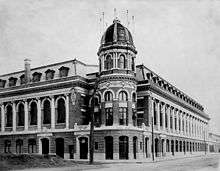
The lowest point came in 1941, when the Phillies finished with a 43–111 record, setting a franchise record for losses in a season. A year later, they needed an advance from the league just to go to spring training. Nugent realized he did not have enough money to operate the team in 1943, and put it up for sale.
After lumber baron William D. Cox purchased the team in 1943, the Phillies rose out of last place for the first time in five years. As a result, the fan base and attendance at home games increased. Eventually, Cox revealed that he had been betting on the Phillies, and he was banned from baseball. The new owner, Bob Carpenter Sr., scion of the Delaware-based duPont family, tried to polish the team's image and way of doing business. Carpenter named his son, Bob Carpenter, Jr., team president. They wanted to shed the image of failure by unofficially changing the team name to the "Blue Jays". However, the new moniker did not take, and it was quietly dropped by 1949; the Blue Jays moniker would be used by Toronto's MLB club when it started play in 1977.[13]
Fightin’ Phils (1949–1970)
Like Cox, Bob Carpenter, Jr. was not afraid to spend the money it took to build a contender. He immediately started signing young players and invested even more money in the farm system.
The Phillies quickly developed a solid core of young players that included future Hall of Famers Richie Ashburn and Robin Roberts. This coincided with the final collapse of the A's. Philadelphia had been an "A's town" for most of the first half of the 20th century. Even though the A's had fielded teams as bad or worse than the Phillies for most years since the 1930s, the A's continued to trounce the Phillies at the gate. However, a series of poor baseball and business decisions on the A's part allowed the Phillies to win the hearts of Philadelphia's long-suffering fans.
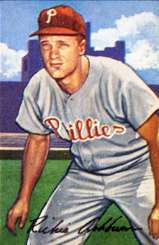
Things started coming together for the Phillies in 1949, when they rocketed up the standings to third place with an 81–73 record. Although the season had essentially been a two-team race between Brooklyn and St. Louis, it was still the Phillies' first appearance in the first division in 31 years. It was also a fitting tribute to Bob Carpenter, Sr., who had died in June and left Bob, Jr. in full control of the team.
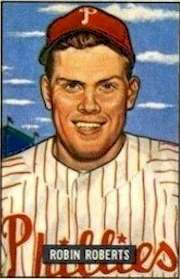
The 1950 Phillies led the National League standings for most of the season and were dubbed the "Whiz Kids". In the final months of the season, a tailspin (triggered by the loss of starting pitcher Curt Simmons to National Guard service) caused the team to lose the next eight of ten games. On the last day of the season, the Phillies hung on to a one-game lead when Dick Sisler’s dramatic tenth inning home run against the Brooklyn Dodgers clinched the Phils' first pennant in 35 years. In the World Series, exhausted from their late-season plunge and victims of poor luck, the Phillies were swept by the New York Yankees in four straight games. Nonetheless, this appearance cemented the Phillies status as the city's favorite team.
In contrast, the Philadelphia Athletics finished last in 1950, and longtime manager Connie Mack retired. The team struggled for four more years with only one winning season before abandoning Philadelphia under the Johnson brothers, who bought out Mack. They began to play in Kansas City in 1955.[14] As part of the deal selling that team to the Johnson brothers, the Phillies bought Shibe Park, where both teams had played since 1938.[15] Many thought that the "Whiz Kids", with a young core of talented players, would be a force in the league for years to come.[16][17] However, the team finished with a 73–81 record in 1951 and finished nine and a half games out of first place in 1952, with an 87–67 record. The Phillies managed to end up in third place in 1953 with an 83–71 record, however, they would fail to break .500 from 1954 to 1957.
It became apparent that the flash and determination of the Whiz Kids would not return when the team finished last place in the National League from 1958 to 1961. Manager Eddie Sawyer abruptly quit the team after the season opener in 1960, and was replaced by Gene Mauch.
The team's competitive futility was highlighted by a record that still stands: in 1961, the Phillies lost 23 games in a row, the worst losing streak in the majors since 1900.
Things started to turn around for the team in 1962 when the team finished above .500 for the first time in five years. Gene Mauch was named National League Manager of the Year that season and won it again in 1964. The team improved in 1963 when the team finished the season with an 87–75 record. There was confidence that the team would soon become contenders for a return to the World Series.
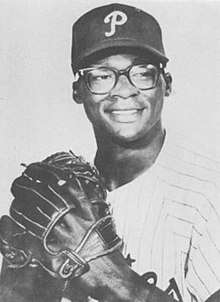
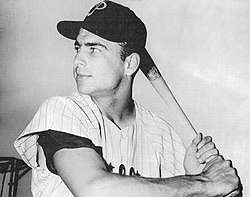
Though Ashburn and Roberts were gone, the 1964 Phillies still had younger pitchers Art Mahaffey, Chris Short, and rookie Ray Culp; veterans Jim Bunning and screwballer Jack Baldschun; and fan favorites Cookie Rojas, Johnny Callison, and NL Rookie of the Year Dick Allen. The team was 90–60 on September 20, good enough for a lead of 6.5 games in the pennant race with 12 games to play. However, the Phillies lost 10 games in a row and finished one game out of first, losing the pennant to the St. Louis Cardinals. The "Phold of '64" is frequently mentioned as the worst collapse in sports history.[18]
One highlight of the 1964 season occurred on Father's Day, when Jim Bunning pitched a perfect game against the New York Mets, the first in Phillies' history.[19]
For the rest of the decade, the team finished no higher than fourth place in the NL standings which came during the 1966 season. In the 1969 season, the Phillies finished fifth the in the newly created NL East Division, with a record of 63–99.
By the late 1950s, Carpenter decided the Phillies needed a new home. He never wanted to buy Connie Mack Stadium in the first place, and was now convinced there was no way he could make money playing there. He sold the park to Philadelphia Eagles' owner Jerry Wolman in 1964, taking a $1 million loss on his purchase of just 10 years earlier. The stadium was deteriorating and there was inadequate parking. Attendance began to drop by 1967 and the team started to plan for a new stadium.
The Phillies remained at Connie Mack Stadium until 1970. In the last game played there, the Phillies avoided last place by beating the Expos 2–1. When the game was finished several fans in attendance began to remove items from the ballpark, such as chairs, outfield panels and baseball equipment from the dugouts.
Glory days (1971–1984)
The Phillies opened the new Veterans Stadium in 1971. The team wore new maroon uniforms to accentuate the change. The stadium was built in South Philadelphia, making it the first time the team was not located in North Philadelphia. The new stadium, along with nearby John F. Kennedy Stadium and the Spectrum, established the South Philadelphia Sports Complex.

Pitcher Rick Wise hurled a no-hitter and in the same game hit two home runs against the Cincinnati Reds in 1971. That same season, Harry Kalas joined the Phillies broadcasting team.
In 1972, the Phillies were the worst team in baseball, but newly acquired Steve Carlton won nearly half their games (27 of 59 team wins) and was awarded his first NL Cy Young Award and won it again in 1977. Bob Carpenter, Jr. retired in 1972 and passed the team ownership to his son Ruly.
The Phillies achieved some success in the mid-1970s. With players such as Carlton, third baseman Mike Schmidt, shortstop Larry Bowa, and outfielder Greg Luzinski, the Phillies won three straight division titles (1976–78). However, they fell short in the NLCS, against the Reds in 1976 and the Dodgers in 1977 and 1978. In 1979, the Phillies acquired Pete Rose, the spark that would put them over the top.
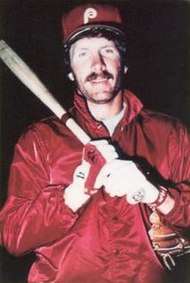
World Series Champions (1980)
The Phillies won the NL East in 1980, but to win the league championship, they had to defeat the Houston Astros. In a memorable NLCS, with four of the five games needing extra innings, they fell behind 2–1 but battled back to squeeze past the Astros on a 10th-inning game-winning hit by center fielder Garry Maddox, and the city celebrated its first NL pennant in 30 years.[20] The entire series saw only one home run hit, a game-winning two-run home run by Phillies slugger Greg Luzinski in the Phillies' opening 3–1 win in Game 1 at Philadelphia.
Facing the Kansas City Royals in the 1980 World Series, the Phillies won their first World Series championship ever in six games thanks to the timely hitting of Mike Schmidt and Pete Rose. Schmidt, who was the National League MVP that 1980 season, also won the World Series MVP award on the strength of his 8-for-21 hitting (.381 average), including game-winning hits in Game 2 and the clinching Game 6. This final game was also significant because it remains "the most-watched game in World Series history" with a television audience of 54.9 million viewers.[21] Thus, the Phillies became the last of the 16 teams that made up the major leagues from 1901 to 1961 to win a World Series.[22] Carlton captured his third NL Cy Young Award with a record of 24–9.

After their series win, Ruly Carpenter, who had been given control of the team in 1972 when his father stepped down as team president, sold the team for $32.5 million in 1981 to a group that was headed by longtime Phillies' executive Bill Giles.
The Phillies returned to the playoffs in 1981, which were split in half due to a players' strike. In five games, they were defeated in the first-ever National League Division Series by the Montreal Expos. Mike Schmidt won his second consecutive NL MVP award that year. In 1982, the team finished three games behind the St. Louis Cardinals in the East Division, narrowly missing the playoffs. Carlton captured his fourth career NL Cy Young Award that year with 23 wins.
For the 1983 season, the Phillies returned to the playoffs and beat the Los Angeles Dodgers. They won this series in four games to capture their fourth NL pennant; however, they lost to the Baltimore Orioles in the World Series in five games. John Denny was named the 1983 NL Cy Young Award winner. Because of the numerous veterans on the 1983 team, Philadelphia Daily News sportswriter Stan Hochman gave them the nickname, the "Wheeze Kids".[23]
In 1984 the team finished fourth in the NL East with a record of 81–81. Mike Schmidt still remained a dominant force on the team by leading the National League in both home runs and RBI's.
End of days (1985–1991)
The 1985 season was the first time the team finished below .500 since 1974. The team had some success in 1986 despite having released star pitcher Steve Carlton due to injuries. They went on to finish second in the division with a record of 86–75. Mike Schmidt led the National League in home runs and RBI's that year and also won his third NL MVP award, sixth Silver Slugger award and tenth Gold Glove.
In 1987 closer Steve Bedrosian was named the NL Cy Young Award winner.
Injuries caused Mike Schmidt to miss most of the 1988 season and he retired from baseball after playing in only 42 games in 1989, thus the last member of the 1980 championship team was gone.
In 1990, Terry Mulholland lost a perfect game in the seventh inning when a San Francisco Giants' batter reached base on a throwing error. The next batter grounded into a double play. Thus, Mulholland faced the perfect-game maximum of 27 batters, but did not qualify for a perfect game. He was credited, however, with a no-hitter.[24]
During this time, the Phillies often struggled to attract more than 25,000 people to Veterans Stadium, the biggest in the National League at the time (at over 62,000 people). Even crowds of 40,000 were swallowed up by the cavernous environment.
"Macho Row" (1992–1995)
Before the 1992 season the organization decided to shed the maroon uniform and logo and use colors similar to those used during the days of the "Whiz Kids". The season ended with the Phillies at the bottom of the standings—last place in the National League East. However, their fortunes were about to change.
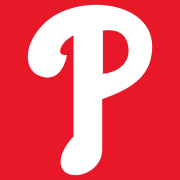
The 1993 Phillies were led by stars such as Darren Daulton, John Kruk, Lenny Dykstra, and Curt Schilling. The team was dubbed "Macho Row" for their shaggy, unkempt, and dirty look. Their character endeared them to fans, and attendance reached a record high the following season.
The team powered their way to a 97–65 record and an NL East division title, all thanks to a big April in which the Phillies went 17–5. The Phillies' major contributors on offense were Dykstra, Kruk, Kevin Stocker (a rookie who led the team in batting average, hitting .324), and Jim Eisenreich, all of whom hit over .300 for the season. Their pitching staff was led by 16-game winners Curt Schilling and Tommy Greene. Each member of the rotation posted at least 10 wins, while the bullpen was led by elder statesman Larry Andersen and closer Mitch "Wild Thing" Williams, who notched 43 saves and a 3.34 ERA.
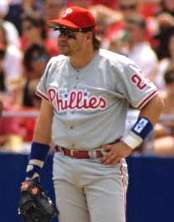
They beat the Atlanta Braves in the 1993 National League Championship Series, four games to two, to earn the fifth NL pennant in franchise history, only to be defeated by the defending World Series champion Toronto Blue Jays in the 1993 World Series.[25] Toronto's Joe Carter hit a walk-off home run in Game 6 to clinch another Phillies' loss.[26]
The 1994–95 Major League Baseball strike was a blow to attendance and on-field success, as was the arrival of the Atlanta Braves in the division due to league realignment. Several players from the 1993 team were either traded or left the team soon after.
Rebuilding years (1996–2002)
The team drafted third baseman Scott Rolen in the second round of the 1993 amateur draft. He had reached the majors by 1996 and was named National League Rookie of the Year in 1997. After becoming frustrated with management he demanded a trade and was dealt to the St. Louis Cardinals in 2002.
Between 1996 and 2002 the team drafted players who would soon become the core of the team including Jimmy Rollins, Pat Burrell, Chase Utley, Ryan Howard, and Cole Hamels.
Former Phillie Larry Bowa was hired as manager for the 2001 season, and led the Phillies to an 86–76 record, their first winning season since the 1993 World Series year. They spent most of the first half of the season in first place, and traded first place with the Braves for most of the second half. In the end, they finished two games out of first. Bowa was named National League Manager of the Year.
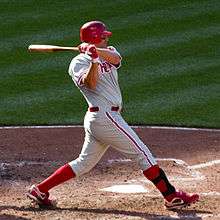
The Phillies continued to contend for the next few years under Bowa, with the only blemish being an 80–81 season in 2002. On December 6, 2002, Jim Thome, who was a free agent, signed a six-year, $85 million contract with the team.[27]
The Golden era (2003–2012)
The Phillies' win-loss record never went below .500 during this time; and the team won the NL East five years in a row from 2007 to 2011.[28] In 2004, the Phillies moved to their new home, Citizens Bank Park,[29] across the street from Veterans Stadium.
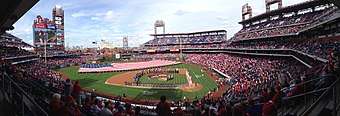
Charlie Manuel took over the club's reins from Bowa after the 2004 season, and general manager Ed Wade was replaced by Pat Gillick in November 2005. Gillick reshaped the club as his own, bringing in players such as Shane Victorino, Jayson Werth, and Jamie Moyer.
Ryan Howard was named NL MVP for the 2006 season and Jimmy Rollins followed up the next year as the 2007 NL MVP. After the franchise lost its 10,000th game in 2007,[30] its core of young players responded by winning the National League East division title, but they were swept by the Colorado Rockies in the Division Series.[31] After the 2007 season, they acquired closer Brad Lidge through a trade with the Houston Astros.
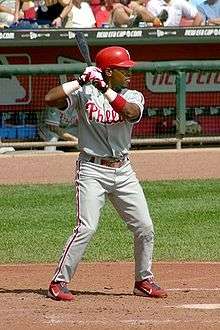
World Series Champions (2008)
Though the Phillies were named in some publications as the favorites to repeat as division champions in 2008, they did not get off to the blazing April start that many had hoped for. Still, they managed their first winning opening month since 2003, and only their fourth since their last World Series appearance.
With a batting average of .360 and his MLB-leading 11 home runs, Chase Utley paced the team's offense, followed closely by a resurgent Pat Burrell and his 25 runs batted in. Though team speed was hampered by the loss of Shane Victorino and Jimmy Rollins to the disabled list, the latter for the first time in his career, the Phillies still pushed forward to a 15–13 record.
.jpg)
June was a tale of two halves for the Phillies, as they ended May and started June with a strong run of offense and excellent pitching. From May 26 to June 13, the Phillies posted a 14–4 record, starting their run with a 15–6 win over the Astros and ending with a 20–2 win over the Cardinals. However, the offense took a downturn as the Phillies' pitchers began to sacrifice more runs in the latter part of the month. The Phillies went 3–11 for the remainder of June, with their pitchers allowing an average of 4.79 runs per game, to the offense's 3.36 runs scored per game.
July began with the announcement that Chase Utley and Brad Lidge would represent the team at the 2008 Major League Baseball All-Star Game,[32] with Utley garnering the most votes of all National League players.[33]
The Phillies went 8–4 in July before the All-Star break, compiling a four-game win streak, a four-game losing streak, and winning four of their last five. In a move to bolster their starting rotation in preparation for the pennant race, the Phillies traded three minor league players to the Athletics for starting pitcher Joe Blanton on July 17.[34]
On September 27, the Phillies clinched the National League East for the second year in a row, once again helped by a late September slump by the New York Mets. The Phillies redeemed their previous year's playoff performance by winning the NLDS three games to one against the Milwaukee Brewers, and they defeated the Dodgers in Los Angeles as well, 4–1.As the National League champions, the Phillies advanced to the 2008 World Series to play the Tampa Bay Rays. After a power outage by the offense in which they went 1 for 33 with runners in scoring position and the first-ever suspended postseason game in World Series history in game five, the Phillies rode their pitching rotation to a 4–1 victory in the Fall Classic. Cole Hamels was named the series MVP for both the NLCS and the World Series.
Pat Gillick retired as general manager after the 2008 season and was succeeded by one of his assistants, Rubén Amaro, Jr. After adding outfielder Raúl Ibañez to replace the departed Pat Burrell, the Phillies retained the majority of their core players for the 2009 season. In July, they signed three-time Cy Young Award winner Pedro Martínez and acquired 2008 American League Cy Young winner Cliff Lee before the trade deadline. On September 30, 2009, they clinched a third consecutive National League East Division title for the first time since the 1976–78 seasons.
.jpg)
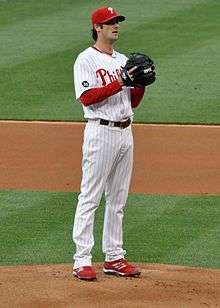
The team continued this successful run with wins over the Colorado Rockies in the NLDS and the Los Angeles Dodgers in the NLCS, to become the first Phillies team to win back-to-back pennants and the first National League team since the 1996 Atlanta Braves to have an opportunity to defend their World Series title. The Phillies were unable to repeat the 2008 World Series victory; they were defeated in the 2009 series by the New York Yankees, four games to two. In recognition of the team's recent accomplishments, Baseball America named the Phillies its Organization of the Year.[35]
On December 16, 2009, they acquired starting pitcher Roy Halladay from the Toronto Blue Jays for three minor-league prospects,[36] and traded Cliff Lee to the Seattle Mariners for three prospects.[37] On May 29, 2010, Halladay pitched a perfect game against the Florida Marlins.[d] In June 2010, the team's scheduled series against the Toronto Blue Jays at Rogers Centre was moved to Philadelphia, because of security concerns for the G-20 Summit. The Blue Jays wore their home white uniforms and batted last as the home team, and the designated hitter was used.[38] The game was the first occasion of the use of a designated hitter in a National League ballpark in a regular-season game; Ryan Howard was the first player to fill the role.[39]
The 2010 Phillies won their fourth consecutive NL East Division championship[40][41] despite a rash of significant injuries to key players.[42] After dropping seven games behind the Atlanta Braves on July 21, Philadelphia finished with an MLB-best record of 97–65.[43] The streak included a 20–5 record in September, the Phillies' best September since winning 22 games that month in 1983,[44] and an 11–0 run in the middle of the month.[45] The acquisition of pitcher Roy Oswalt in early August was a key step, as Oswalt won seven consecutive games in just over five weeks from August 11 through September 17.[45] The Phillies clinched the division on September 27, behind a two-hit shutout by Halladay.[46]
In Game 1 of the 2010 National League Division Series, Halladay threw the second no-hitter in Major League baseball postseason history, leading the Phillies over the Cincinnati Reds, 4–0. (The first was New York Yankee pitcher Don Larsen's perfect game in the 1956 World Series.[47]) Halladay's no-hitter was the fifth time a pitcher has thrown two no-hitters in the same season, and was also the first time that one of the two occurred in the postseason. The Phillies went on to sweep the Reds in three straight games.
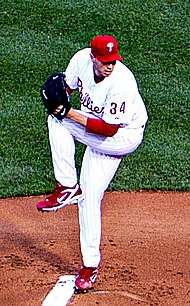
In the 2010 National League Championship Series, the Phillies fell to the eventual World Series champion San Francisco Giants in six games. Halladay was named the 2010 NL Cy Young Award winner.
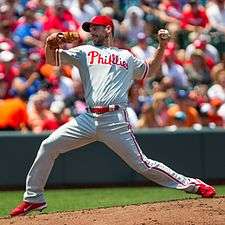
Before the start of the 2011 season, the Phillies signed pitcher Cliff Lee to a five-year deal, bringing him back to the team and forming a formidable rotation of Halladay, Lee, Hamels, Oswalt, and Blanton. Including Vance Worley, who replaced Joe Blanton due to injury. The rotation combined for a win-loss record of 71–38. and an ERA of 2.86; the best in the majors that year. Commentators called it one of the best rotations ever assembled.[48][49][50][51] Halladay, Oswalt, Lee, and Hamels were dubbed two nicknames by fans & media: the 'Phantastic Phour' and "The Four Aces".[50] On September 17, 2011, the Phillies won their fifth consecutive East Division championship,[52] and on September 28, during the final game of the season, the team set a franchise record for victories in a season with 102 by beating the Atlanta Braves in 13 innings, denying their division rivals a potential wild card berth.[53] Yet the Phillies lost in the NLDS to the St. Louis Cardinals—the team that won the National League Wild Card as a result of the Phillies beating the Braves. The Cardinals subsequently beat the Brewers in the NLCS and won the 2011 World Series in seven games over the Texas Rangers.
The 2012 Phillies experienced an up and down season. They played .500 ball through the first two months, but then slumped through a 9–19 stretch in June where they ended up at the bottom of the NL East by mid season. With any hope dimming, the Phillies traded key players Shane Victorino and Joe Blanton to the Los Angeles Dodgers, and Hunter Pence to the San Francisco Giants before the trade deadline. A hot start in the second half of the season put the Phillies back on the postseason hunt, but any hope was eventually extinguished with a loss to the Washington Nationals on September 28, costing the Phillies the postseason for the first time since 2006.
Current era (2013–present)
During the 2013 season, the team struggled again, and was unable to consistently play well for the majority of the season. On August 16, 2013, with the team's record at 53–68, the Phillies fired manager Charlie Manuel, who had managed the team since 2005,[54] and promoted third-base coach Ryne Sandberg to interim manager. Manuel had spent over nine years as manager, leading Philadelphia to its first World Series victory in nearly 30 years and amassing an overall record of 780–636 to become the manager with the most wins in the franchise's history. The 2013 Phillies ended up with a record of 73–89, their first losing season since 2002. In the off-season pitcher Roy Halladay retired from baseball.
In the 2014 season, one of the few bright spots was the September 1 game against a division rival, the Atlanta Braves, when starter Cole Hamels and relievers Jake Diekman, Ken Giles, and Jonathan Papelbon combined for a no-hitter at Turner Field and a 7–0 victory over Atlanta. In the first round of the 2014 MLB Draft the Phillies selected pitcher Aaron Nola with the 7th overall pick. The team could not gain momentum during the season and finished last in the NL East, the first time they had done so since 2000. During the off season, Jimmy Rollins waived his no-trade clause and was traded to the Los Angeles Dodgers, while Cliff Lee pitched his last game and was sidelined for the entire 2015 season due to injury.
In 2015, attendance began to drop as the team showed little improvement and it was clear that the remnants of the 2008 World Series team would soon be departing. Sandberg resigned as manager and bench coach Pete Mackanin was brought in as interim manager. Cole Hamels no-hit the Chicago Cubs 5–0 at Wrigley Field, on July 25, striking out 13 and only giving up two walks.[55] It was the first no-hitter against the Cubs since Sandy Koufax's perfect game in 1965, and first at Wrigley Field since the Cubs' Milt Pappas in 1972.[56] Hamels was dealt to the Texas Rangers, six days later.[57][58] The following month saw the departure of Chase Utley who was traded to the Dodgers. In September general manager Rubén Amaro, Jr. was fired and Andy MacPhail was brought in as the interim GM.[59] The team once again finished last in the NL East with a record of 63–99. McPhail was officially named the organization's President of Baseball Operations during the off season.[60] The team then hired Matt Klentak as the new GM.
In 2016 the team finished fourth in the NL East, only winning eight more games than they had the previous year, with a 71–91 record. The 2016 season was the last for both Ryan Howard and Carlos Ruiz in a Phillies' uniform. Ruiz was traded to the Dodgers in late August, reuniting him with Chase Utley. The team decided to not exercise their club option on Howard, thus making him a free agent.
On September 29, 2017, Pete Mackanin was fired as manager. The Phillies announced Gabe Kapler as their new manager on October 30, 2017.[61] Kapler had been the Director of Player Development for the Los Angeles Dodgers since November 2014. He led the Phillies in the right direction in the first half of the 2018 season, as they had a 59–48 record at the July 31st trade deadline and were leading the NL East division by 1.5 games over the Atlanta Braves.[62] However, a late season collapse where they went 21–34 from August to the end of the season led to the Phillies finishing with an 80–82 record and third in the division. Aaron Nola amassed a record of 17–6 with a 2.37 ERA and 0.975 WHIP.[63] He finished third in the National League Cy Young race, behind the Nationals' Max Scherzer and the winner, the Mets' Jacob DeGrom.[64]
_(cropped).jpg)
The Phillies had been waiting for the 2018 off-season since the start of their rebuild, targeting valuable free agents. Owner John Middleton said they were willing to "spend stupid money".[65] During the off-season, the Phillies signed Andrew McCutchen, David Robertson, and making the splash of the off-season, signed Bryce Harper to a 13-year, $330 million deal. The team also made many trades, including trading for the Mariners' shortstop Jean Segura and the Marlins' J.T. Realmuto.[66] The Philies got off to a hot start the first two months, going 33–22 but collapsed from there. They were eliminated on September 24 in the first game of a day-night double-header in Washington, DC, and finished with a record of 81–81. Owner John Middleton fired Manager Gabe Kapler on October 10, 2019, after ten days of intense deliberations with insiders and outsiders alike.[67]
On October 24, 2019, the Philadelphia Phillies announced Joe Girardi as their 55th manager of the Philadelphia Phillies signing a three-year deal with the team with an option for the 2023 season.[68]
Team uniform
Current uniform
The current team colors, uniform, and logo date to 1992. The main team colors are red and white, with blue serving as a prominent accent. The team name is written in red with a blue star serving as the dot over the "i"s, and blue piping is often found in Phillies' branded apparel and materials. The team's home uniform is white with red pinstripes, lettering and numbering. The road uniform is traditional grey with red lettering/numbering. Both bear a script-lettered "Phillies" logo, with the aforementioned star dotting the "i"s across the chest, and the player name and number on the back. The uniform's front script has undergone minor changes over the years.[69] Hats are red with a single stylized "P".[70] The uniforms and logo are very similar to those used during the "Whiz Kids" era from 1950 to 1969.
The Phillies and the St. Louis Cardinals are the only MLB teams to utilize chain stitching in their chest emblems.
In 2008, the Phillies introduced an alternate, cream-colored uniform during home day games—a tribute to their 125th anniversary. The uniforms are similar to those worn from 1946 through 1949, featuring red lettering bordered with blue piping and lacking pinstripes.[71] The accompanying cap is blue with a red bill and a red stylized "P." The uniforms were announced on November 29, 2007, when Phillies shortstop Jimmy Rollins, pitcher Cole Hamels, and Hall of Fame pitcher Robin Roberts modeled the new uniforms.[72]
For the 2009 season the Phillies wore black, circular "HK" patches over their hearts in memory of broadcaster Harry Kalas, who died April 13, 2009, just before he was to broadcast a Phillies game in Washington, D.C. From Opening Day through July 26, 2009, the Phillies wore 2008 World Champions patches on the right sleeve of their home uniforms to celebrate their World Series victory the season prior. After the death of Hall of Fame pitcher Robin Roberts on May 6, 2010, the Phillies wore a black patch with a white "36" on the sleeves of their jerseys in memory of Roberts for the remainder of the 2010 season. Number 36 had been retired previously by the team in 1962 to honor Roberts. For the 2011 season, the Phillies wore a black circular patch with a "B" in honor of minority owners Alexander and John Buck, who died in late 2010. For the 2014 season, the Phillies wore a black circular patch with initials “CB” in honor of former owner Claire Betz, who died during the offseason. For the 2015 season, the Phillies wore a black circular patch with a white "SLB" in memory of minority owner Sara L. Buck, who died on August 23, 2014. For the 2017 season, the Phillies wore a black circular patch on their sleeves featuring the "baseball stitched" center swirl "P" used from 1970 to 1991 inside the white silhouette of a capital "D" in memory of former manager Dallas Green, who led the franchise to its first World Series championship and died on March 22, 2017.[73] Following the death of former chairman, minority-owner, and president David Montgomery on May 8, 2019, the Phillies added a black circular patch with white "DPM" letters in memory of Montgomery for the remainder of the 2019 season.[74]
In 2016, the Phillies added a red alternate uniform, similar to their spring training uniforms, to be used for mid-week afternoon games. It was unofficially retired following the 2017 season, after which the Phillies revived their powder blue throwbacks as an alternate uniform to be used on select Thursday home games.
The Phillies are one of four teams in Major League Baseball that do not display the name of their city, state, or region on their road jerseys, joining the Los Angeles Angels of Anaheim, St. Louis Cardinals, and the Tampa Bay Rays. The Phillies are the only team that also displays the player's number on one sleeve except on the alternate jersey, in addition to the usual placement on the back of the jersey.
Batting practice
The Phillies were an early adopter of the batting practice jersey in 1977, wearing a maroon v-necked top with the "Phillies" script name across the chest, as well as the player name and number on the back and a player number on the left sleeve, all in white. Larry Bowa, Pete Rose, and Mike Schmidt wore this maroon batting jersey in place of their road jersey during the 1979 All-Star Game in Seattle. Currently, during spring training, the Phillies wear solid red practice jerseys with pinstriped pants for Grapefruit League home games. The red jerseys are worn with grey pants on the road.
Former uniforms
From 1970 to 1991, the Phillies sported colors, uniforms, and a logo that were noticeably different from what had come before, or since, but that were widely embraced by even traditionally minded fans. A dark burgundy was adopted as the main team color, with a classic pinstripe style for home uniforms. Blue was almost entirely dropped as part of the team's official color scheme, except in one area; a pale blue (as opposed to traditional grey) was used as the base-color for away game uniforms from 1972 to 1988. Yet the most important aspect of the 1970 uniform change was the adoption of one of the more distinctive logos in sports; a Phillies "P" that, thanks to its unique shape and "baseball stitched" center swirl, remained instantly recognizable and admired, long after its regular use had ended. It was while wearing this uniform style and color motif that the club achieved its most enduring success, including a World Series title in 1980 and another World Series appearance in 1983.[69] Its continued popularity with fans is still evident. Even today Phillies' home games can contain many fans sporting caps, shirts, and/or jackets emblazoned with the iconic "P" and burgundy color scheme. The current team has worn the burgundy and powder blue throwbacks whenever their opponents are wearing throwback uniforms from that era. Additionally, this uniform also marked the first appearance of "racing stripes" on a baseball uniform (striping going down the jersey shoulders, the side of the pants and up to the sides of the jersey up to the armpit), which would be seen several other MLB teams for the next quarter-century.
Controversial uniform changes
In 1979, the Phillies' front office modified the uniform into an all-burgundy version with white trimmings, to be worn for Saturday games.[75] They were called "Saturday Night Specials" and were worn for the first and last time on May 19, 1979,[76] a 10–5 loss to the Montreal Expos.[77] The immediate reaction of the media, fans, and players alike was negative, with many describing the despised uniforms as pajama-like. As such, the idea was hastily abandoned.[78] Mike Schmidt did wear the uniform during the MLB All-Star Tour of Japan following the 1979 season. During the closing ceremonies at Veterans Stadium on September 28, 2003, there was a procession of former players during the post-game ceremony, most in uniform. Larry Christenson, the starting pitcher in the original game, came out wearing this old burgundy uniform, and was the only one to do so. The Phillies wore this jersey again for the 40th anniversary of the original game on July 27, 2019. Christenson threw out the ceremonial first pitch. They lost to the Atlanta Braves 15–7.[79]
Another uniform controversy arose in 1994 when the Phillies introduced all-blue caps on Opening Day that were to be worn for home day games only.[80] The caps were unpopular with the players, who considered them bad luck after two losses and wanted them discontinued. Management wanted to keep using the caps as planned, as they sold well to fans. A compromise was reached: the players agreed to wear them for weekday games while returning to the customary red caps for Sunday afternoon games.[81] In all, the Phillies wore the "unlucky" blue caps for seven games in 1994, losing six (the lone victory a 5–2 triumph over the Florida Marlins on June 29).[82] A slightly different blue cap (with a red bill) was introduced in 2008 as part of the alternate home uniform for day games, a throwback to the late 1940s.
Rivalries
New York Mets
The rivalry between the New York Mets and the Phillies has been said to be among the "hottest" rivalries in the National League.[83][84] The two National League East divisional rivals have met each other recently in playoff, division, and wild card races.
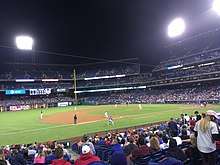
Aside from several brawls in the 1980s, the rivalry remained low-key before the 2006 season,[85] as the teams had seldom been equally good at the same time. Since 2006, the teams have battled for playoff position. The Mets won the division in 2006 and contended in 2007 and 2008, while the Phillies won five consecutive division titles from 2007 to 2011.[86] The Phillies' 2007 Eastern Division Title was won on the last day of the season as the Mets lost a seven-game lead with 17 games remaining.
Pittsburgh Pirates
The rivalry between the Phillies and the Pittsburgh Pirates was considered by some to be one of the best rivalries in the National League.[87][88][89] The rivalry started when the Pittsburgh Pirates entered National League play in their fifth season of 1887, four years after the Phillies.[90]
The Phillies and the Pirates had remained together after the National League split into two divisions in 1969. During the period of two-division play (1969–1993), the two National League East division rivals won the two highest numbers of division championships, reigning exclusively as NL East champions in the 1970s and again in the early 1990s,[90][91] the Pirates nine, the Phillies six; together, the teams' 15 championships accounted for more than half of the 25 NL East championships during that span.[92]
After the Pirates moved to the National League Central in 1994, the teams face each other in only two series each year and the rivalry has diminished.[89] However, many fans, especially older ones, retain their dislike for the other team and regional differences between Eastern and Western Pennsylvania still fuel the rivalry.[93] The rivalry between the Philadelphia Flyers and the Pittsburgh Penguins in the National Hockey League is also fiercely contested.[93][94]
Historical rivalries
City Series: Philadelphia Athletics
The City Series was the name of a series of baseball games played between the Philadelphia Athletics of the American League and the Phillies that ran from 1903 through 1955. After the A's move to Kansas City, Missouri, in 1955, the City Series rivalry came to an end. The teams have since faced each other in Interleague play (since its introduction in 1997) but the rivalry has effectively died in the intervening years since the A's left Philadelphia. In 2014, when the A's faced the Phillies in inter-league play at Oakland Coliseum, the Athletics did not bother to mark the historical connection, going so far as to have a Connie Mack promotion the day before the series while the Texas Rangers were in Oakland.[95]
The first City Series was held in 1883 between the Phillies and the American Association's Athletics.[96] When the Athletics first joined the American League, the two teams played each other in a spring and fall series. No City Series was held in 1901 and 1902 due to legal warring between the National and American Leagues.
Roster
Philadelphia Phillies roster | ||||||
|---|---|---|---|---|---|---|
| Active roster | Player pool | Coaches/Other | ||||
|
Pitchers
Bullpen
Closer
|
Catchers Infielders
Outfielders
|
Pitchers
Catchers
Infielders
Outfielders
|
Manager
Coaches
45-day injured list COVID-19 related list
28 active, 24 player pool
| |||
Team records
Team managers
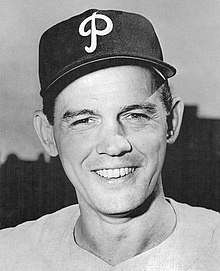
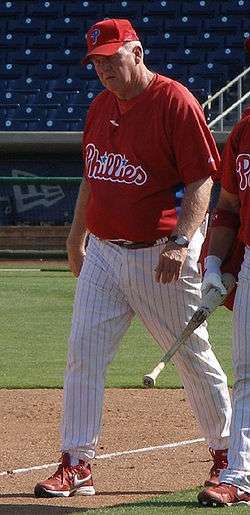
Over 126 seasons, the Phillies' franchise has employed 54 managers.[97] The duties of the team manager include team strategy and leadership on and off the field.[98] Seven managers have taken the Phillies to the postseason, with Danny Ozark and Charlie Manuel each leading the team to at least three playoff appearances. Manuel and Dallas Green are the only Phillies' managers to win a World Series: Green in 1980 against the Kansas City Royals; and Manuel in 2008 against the Tampa Bay Rays.[99] Charlie Manuel is the longest-tenured manager in franchise history, with 1,416 games of service in parts of nine seasons (2005–2013).[100] The records and accomplishments of Phillies' managers since 1991 are shown below.
| Winning percentage: number of wins divided by number of games managed | |
| Playoff appearances: number of years this manager has led the franchise to the playoffs | |
| Playoff wins: number of wins this manager has accrued in the playoffs | |
| Playoff losses: number of losses this manager has accrued in the playoffs | |
| World Series: number of World Series victories achieved by the manager | |
| Elected to the National Baseball Hall of Fame (‡ denotes induction as manager)[101] | |
| Member of the Philadelphia Baseball Wall of Fame |
| #[a] | Manager | Years | Wins | Losses | Ties | WPct | PA | PW | PL | WS | Ref |
|---|---|---|---|---|---|---|---|---|---|---|---|
| 47 | Jim Fregosi | 1991–1996 | 431 | 463 | 0 | .482 | 1 | 6 | 6 | 0 | [102][103] |
| 48 | Terry Francona | 1997–2000 | 285 | 363 | 0 | .440 | — | — | — | — | [104] |
| 49 | Larry Bowa§[b] | 2001–2004 | 337 | 308 | 0 | .522 | — | — | — | — | [105] |
| 50 | Gary Varsho | 2004 | 1 | 1 | 0 | .500 | — | — | — | — | [106] |
| 51 | Charlie Manuel§ | 2005–2013 | 780 | 636 | 0 | .551 | 5 | 27 | 18 | 1 | [107][108] [109][110] |
| 52 | Ryne Sandberg† | 2013–2015 | 119 | 159 | 0 | .428 | — | — | — | — | [111] |
| 53 | Pete Mackanin | 2015–2017 | 174 | 238 | 0 | .422 | — | — | — | — | |
| 54 | Gabe Kapler | 2018–2019 | 161 | 163 | 0 | .497 | — | — | — | — | |
| 55 | Joe Girardi | starting 2020 | 0 | 0 | 0 | .000 | — | — | — | — | |
Statistics current through October 24, 2019
Achievements
Awards
Five Phillies have won MVP awards during their career with the team. Mike Schmidt leads with three wins, with back-to-back MVPs in 1980 and 1981, and in 1986 as well. Chuck Klein (1932), Jim Konstanty (1950), Ryan Howard (2006), and Jimmy Rollins (2007) all have one.[112] Pitcher Steve Carlton leads the team in Cy Young Award wins with four (1972, 1977, 1980, and 1982), while John Denny (1983), Steve Bedrosian (1987), and Roy Halladay (2010) each have one.[112] Four Phillies have won Rookie of the Year honors as well. Jack Sanford won in 1957, Dick Allen in 1964. Third baseman Scott Rolen brought home the honors in 1997, while Howard was the most recent Phillies' winner in 2005.[113] In doing so, Howard became only the second player in MLB history to win Rookie of the Year and Most Valuable Player in consecutive years, Cal Ripken, Jr. of the Baltimore Orioles being the first.[114]
Of the 15 players who have hit four home runs in one game, three were Phillies at the time (more than any other team).[115] Ed Delahanty was the first, hitting his four in Chicago's West Side Park on July 13, 1896. Chuck Klein repeated the feat nearly 40 years later to the day, on July 10, 1936, at Pittsburgh's Forbes Field. Forty years later, on April 17, 1976, Mike Schmidt became the third, with his hits in Chicago at Wrigley Field.
Hall of Famers
- See footnote[116]
| Philadelphia Phillies Hall of Famers |
|---|
| Affiliation according to the National Baseball Hall of Fame and Museum |
|
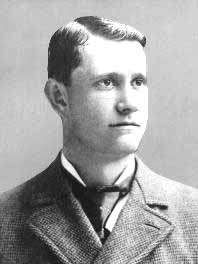
Ford C. Frick Award recipients
| Philadelphia Phillies Ford C. Frick Award recipients | |||||||||
|---|---|---|---|---|---|---|---|---|---|
| Affiliation according to the National Baseball Hall of Fame and Museum | |||||||||
|
Retired numbers and other honors
The Phillies have retired six numbers, and honored two additional players with the letter "P."[117] Grover Cleveland Alexander played with the team in the era before Major League Baseball used uniform numbers, and Chuck Klein wore a variety of numbers with the team during his career. Of the six players with retired numbers, five were retired for their play with the Phillies and one, 42, was universally retired by Major League Baseball when they honored the 50th anniversary of Jackie Robinson's breaking the color barrier. Number 34, once worn by pitcher Roy Halladay, was to be retired on May 29, 2020.[118] Number 15, worn by infielder Dick Allen, will be retired on September 3, 2020.[119]
|
Wall of Fame
From 1978 to 2003, the Phillies inducted one former Phillie and one former member of the Philadelphia Athletics per year. Since 2004 they have inducted one Phillie annually. Players must be retired and must have played at least four years with the Phillies or Athletics. In March 2004, the Athletics plaques were relocated to the Philadelphia Athletics Historical Society in Hatboro, Pennsylvania, and a single plaque listing all of the A's inductees was attached to a statue of Connie Mack located across the street from Citizens Bank Park. The Philles' inductees to the Wall of Fame are listed below (note that there was no inductee for the 2017 season, as Pete Rose was intended to be inducted, but was not due to controversial allegations):
The Wall of Fame was located in Ashburn Alley at Citizens Bank Park from 2004 to 2017, until the 2018 season when it was relocated to a more spacious location behind the left field scoreboard.
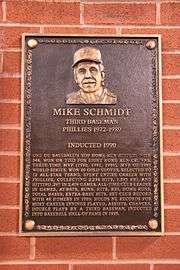
| Member of the National Baseball Hall of Fame and Museum | |
| Bold | Recipient of the Hall of Fame's Ford C. Frick Award |
Centennial Team
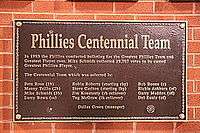
In 1983, rather than inducting a player into the Wall of Fame, the Phillies selected their Centennial Team, commemorating the best players of the first 100 years in franchise history.
| List of players honored as Centennial Team members | |
| Player | Position |
|---|---|
| Richie Ashburn |
CF |
| Bob Boone | C |
| Larry Bowa | SS |
| Steve Carlton |
LHP |
| Garry Maddox | CF |
| Dallas Green | MGR |
| Jim Konstanty | RHP |
| Del Ennis | OF |
| Tug McGraw | LHP |
| Robin Roberts |
RHP |
| Pete Rose | 1B |
| Mike Schmidt |
3B |
| Manny Trillo | 2B |
Philadelphia Sports Hall of Fame
| Phillies in the Philadelphia Sports Hall of Fame | ||||
|---|---|---|---|---|
| Name | Position | Tenure | Inducted | |
| Richie Ashburn | CF Broadcaster | 1948–1959 1963–1997 | 2004 | |
| Steve Carlton | P | 1972–1986 | 2004 | |
| Harry Kalas | Broadcaster | 1971–2009 | 2004 | |
| Robin Roberts | P | 1948–1961 | 2004 | |
| Mike Schmidt | 3B | 1972–1989 | 2004 | |
| Grover Cleveland Alexander | P | 1911–1917, 1930 | 2005 | |
| Bill Campbell | Broadcaster | 1963–1970 | 2005 | |
| Del Ennis | OF | 1946–1956 | 2006 | |
| Chuck Klein | RF | 1928–1933 1936–1939 1940–1944 | 2007 | |
| Ed Delahanty | LF | 1891–1901 | 2008 | |
| Larry Bowa | SS Coach Manager | 1970–1981 2001–2004 1989–1996 2014–present | 2009 | |
| Dick Allen | 1B / 3B | 1963–1969 1975–1976 | 2010 | |
| Tug McGraw | P | 1975–1984 | 2010 | |
| Curt Simmons | P | 1947–1960 | 2011 | |
| Dan Baker | P.A. Announcer | 1972–present | 2012 | |
| Johnny Callison | RF | 1960–1969 | 2012 | |
| Greg Luzinski | LF | 1970–1980 | 2013 | |
| Bucky Walters | P / 3B | 1934–1938 | 2013 | |
| Chief Bender | P | 1916–1917 | 2014 | |
| By Saam | Broadcaster | 1939–1950 1955–1975 | 2014 | |
| Curt Schilling | P | 1992–2000 | 2014 | |
| Garry Maddox | CF | 1975–1986 | 2015 | |
| Sam Thompson | RF | 1889–1898 | 2015 | |
| Charlie Manuel | Manager | 2005–2013 | 2016 | |
| Chris Short | P | 1959–1972 | 2016 | |
| Bob Boone | C | 1972–1981 | 2017 | |
Team captains
- Jimmy Wilson 1927–1928
- Fresco Thompson 1928–1930
- Granny Hamner 1952–1959
- Mike Schmidt 1978–1979
Minor league affiliations
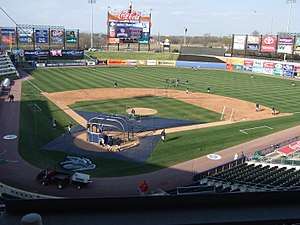
The Philadelphia Phillies farm system consists of nine minor league affiliates.[169]
| Level | Team | League | Location |
|---|---|---|---|
| Triple-A | Lehigh Valley IronPigs | International League | Allentown, Pennsylvania |
| Double-A | Reading Fightin Phils | Eastern League | Reading, Pennsylvania |
| Class A-Advanced | Clearwater Threshers | Florida State League | Clearwater, Florida |
| Class A | Lakewood BlueClaws | South Atlantic League | Lakewood, New Jersey |
| Class A Short Season | Williamsport Crosscutters | New York–Penn League | Williamsport, Pennsylvania |
| Rookie | GCL Phillies East | Gulf Coast League | Clearwater, Florida |
| GCL Phillies West | |||
| DSL Phillies Red | Dominican Summer League | Santo Domingo, Distrito Nacional | |
| DSL Phillies White |
Radio and television
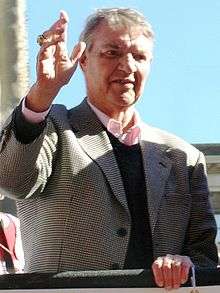
As of 2018, the Phillies' flagship radio stations is WIP-FM (94.1 FM), formerly owned by CBS Radio but since November 2017, owned by Philadelphia-area company Entercom. The broadcasts were discontinued on the former AM flagship station WPHT 1210 in 2016.[170] Scott Franzke and Jim Jackson provide play-by-play on the radio, with Larry Andersen and Kevin Frandsen as color commentators. Meanwhile, NBCUniversal (a unit of Philadelphia-based Comcast) handles local television broadcasts through its properties NBC Sports Philadelphia and WCAU (NBC Channel 10). Tom McCarthy calls play-by-play for the television broadcasts, with Ben Davis, Mike Schmidt, Jimmy Rollins[171] and John Kruk providing color commentary and Gregg Murphy providing field reports and occasional play-by-play.
Spanish language broadcasts are on WTTM (1680 AM)[172] with Danny Martinez on play-by-play, and Bill Kulik and Rickie Ricardo on color commentary.
Other popular Phillies broadcasters through the years include By Saam (1939–1975), Bill Campbell (1962–1970), Richie Ashburn (1963–1997), and Harry Kalas (1971–2009).[173] Kalas, a 2002 recipient of the Ford Frick Award and an icon in the Philadelphia area, called play-by-play in the first three and last three innings on television and the fourth inning on the radio until his death on April 13, 2009.
At Citizens Bank Park, the restaurant built into the base of the main scoreboard is named "Harry the K's" in Kalas' honor. After his death, the Phillies' TV-broadcast booth was renamed "The Harry Kalas Broadcast Booth". It is directly next to the radio-broadcast booth, which is named "The Richie 'Whitey' Ashburn Broadcast Booth". When the Phillies win at home, Kalas' rendition of the song "High Hopes", which he would sing when the Phillies had clinched a playoff berth or advanced in the playoffs, is played as fans file out of the stadium. In addition, when a Phillies' player hits a home run a recording of Kalas' famous "That ball is outta here!" home run call is played. The sole exception is Chase Utley, once the subject of another famous Kalas call, "Chase Utley, you are The Man!", which is played when Utley hits a homer.
In 2011, the Phillies unveiled a statue of Harry Kalas at Citizens Bank Park. It was funded by Phillies' fans and designed and constructed by a Phillies' fan.
The Phillies' public-address (PA) announcer is Dan Baker, who started in the 1972 season.[174][175]
In 2011, the Phillies spent $10 million to upgrade the video system at Citizens Bank Park, including a new display screen in left field, the largest in the National League.[176][177]
Community
Charitable contributions
Since 1984, the Phillies have supported research related to amyotrophic lateral sclerosis (ALS, also known as Lou Gehrig's disease) with the "Phillies Phestival".[178] The team raised over US$750,000 for ALS research at their 2008 festival, compared with approximately $4,500 at the inaugural event in 1984;[178] the event has raised over $10 million in its history.[179] The ALS Association of Philadelphia is the Phillies' primary charity,[180] and the hospitals they support include Pennsylvania Hospital, Thomas Jefferson University Hospital, and Hahnemann University Hospital.[178] Former Phillies' pitchers Geoff Geary, who lost a friend to the disease,[181] and Curt Schilling, who retired with the Boston Red Sox,[182] are still involved with the Phillies' cause.
Education programs
The Phillies have a reading incentive program called Phanatic About Reading, which is designed to encourage students from kindergarten to eighth grade to read for a minimum of 15 minutes a night. This reading program is designed to help students with their literacy skills and comprehension. Phillies Phundamentals is another educational program, offered through after-school and summer camps, that is designed to make learning fun and support academic skills by using baseball.
The Phillies celebrate teachers during their annual Teacher Appreciation Night.[183]
Fan support and reputation
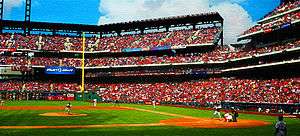
- See footnote[184]
Phillies' fans have earned a reputation over the years for their occasional unruly behavior. In the 1960s, radio announcers for visiting teams would frequently report on the numerous fights breaking out in Connie Mack Stadium.[185] Immediately after the final game at the old park, many fans ran onto the field or dislodged parts of the ballpark to take home with them.[186] Later, at Veterans Stadium, the 700 Level gained a reputation for its "hostile taunting, fighting, public urination and general strangeness".[187] Phillies fans are famously known for their reputation for being the "Meanest Fans in America".[188]
Phillies' fans are known for harsh criticism of their own stars such the 1964 Rookie of the Year Richie Allen and Hall of Fame third baseman Mike Schmidt. The fans, however, are just as well known for heckling the visiting team. Los Angeles Dodgers pitcher Burt Hooton's poor performance during game three of the 1977 NLCS[189] has often been attributed to the crowd's taunting.[190] J. D. Drew, the Phillies' first overall draft pick in the amateur draft of 1997, never signed with the Phillies following a contract dispute with the team, instead re-entering the draft the next year to be drafted by the St. Louis Cardinals.[191] Phillies fans were angered over this disrespect and hurled debris, including two D batteries, at Drew during an August 1999 game.[192]

Many sportswriters have noted the passionate presence of Phillies fans. Allen Barra wrote that the biggest roar he ever heard from Philadelphia fans was in 1980 when Tug McGraw, in the victory parade after the World Series, told New York fans they could "take this championship and shove it."[193]
When the Phillies moved to Veteran's Stadium, they hired a group of young ladies to serve as ushers. These women wore maroon-colored outfits featuring hot pants and were called the Hot Pants Patrol.[194] The team also introduced a pair of mascots attired in colonial garb, named Philadelphia Phil and Phyllis. In addition to costumed characters, animated Phil and Phyllis figures mounted on the center field facade would "hit" the Liberty Bell after a Phillie' home run. This pair of mascots never achieved any significant level of popularity with fans and were eventually discontinued.[194] In 1978, the team introduced a new mascot, the Phillie Phanatic, who has been called "baseball's best mascot", which has been much more successful and has become closely associated with the marketing of the team.[195]
In Phillies' fan culture, it is also not unusual to replace an "f" with a "ph" in words, such as the Phillie Phanatic.[196]
The club surpassed 100 consecutive sellouts on August 19, 2010, selling out over 50% of their home games and averaging an annual attendance of over 3.1 million fans since moving to Citizens Bank Park;[197] on April 3, 2011, the team broke the three-game series attendance record at the ballpark, having 136,254 fans attend the opening weekend against the Houston Astros.[198]
In 2011 and 2012, the Phillies led the league in attendance with 3,680,718 and 3,565,718 fans, respectively, coming out to watch Phillies baseball.[199][200][201][202][203]
The Phillies now boast active international support groups on social media, with a Philadelphia Phillies' UK Facebook group starting in August 2015 and UK Phillies' Twitter account created in May 2017.[204][205] In March 2018 a Phillies' France account launched in French.[206]
See also
References
- "Going Red! New Phillies Alternate Jersey to Debut April 14 at Citizens Bank Park". MLB.com (Press release). MLB Advanced Media. February 1, 2018. Retrieved December 17, 2018.
The Phillies will also debut a new-look batting practice cap for the regular season, New Era's lightweight, performance based Diamond Era 59FIFTY cap featuring a red crown, blue bill and an embossed National League logo on the wearer's right side.
- "Phillies Uniforms". Phillies.com. MLB Advanced Media. Retrieved December 17, 2018.
- "Nearly traded to the Phillies seven years ago, Saunders 'excited to put on the red pinstripes'". phillyvoice.com. January 25, 2017. Retrieved January 25, 2017.
- "Philadelphia Phillies: A Winning 2017 Or?". Fox Sports. January 27, 2017. Retrieved January 27, 2017.
- "Phillies Front Office". Phillies.com. MLB Advanced Media. Retrieved November 7, 2019.
- "Why Mike Schmidt is the Greatest Phillie of All-Time". NBC Sports Philadelphia. November 3, 2018. Retrieved March 19, 2020.
- "Philadelphia Phillies Team History & Encyclopedia". Baseball Reference. Sports Reference LLC. Retrieved May 24, 2020.
- "1882 Worcester Ruby Legs". Baseball-Reference.com. Retrieved March 7, 2009.
- "1883 Philadelphia Quakers". Baseball-Reference.com. Retrieved March 7, 2009.
- Purdy, Dennis (2006). The Team-by-Team Encyclopedia of Major League Baseball. New York City: Workman. ISBN 0-7611-3943-5.
- "Timeline 1800s". philadelphia.phillies.mlb.com. Retrieved September 13, 2019.
- "A Baseball Myth Exploded" (PDF). sabr.org. Archived from the original (PDF) on March 29, 2005. Retrieved September 13, 2019.
- "Phillies Timeline: 1940s". History Highlights. Philadelphia Phillies. Archived from the original on June 13, 2008. Retrieved June 4, 2008.
- Fleming, Frank (April 9, 2006). "Philadelphia Athletics". sportsecyclopedia.com. Retrieved June 4, 2008.
- "Phillies Timeline: 1950s". History Highlights. Philadelphia Phillies. Retrieved June 4, 2008.
- Hochman, Stan (July 1972). "Robin Roberts Remembers the 'Whiz Kids'". Baseball Digest. Lakeside Publishing Company. 31 (7): 35–38. ISSN 0005-609X.
- Zimniuch, Fran (2005). "Big Leagues, Here I Come". Richie Ashburn Remembered. Sports Publishing LLC. p. 23. ISBN 1-58261-897-6. Retrieved October 29, 2009.
- "Phillies Timeline: 1960s". History Highlights. Philadelphia Phillies. Retrieved June 5, 2008.
- McCoy, Hal (June 13, 2014). "Father's Day to remember: Bunning's perfect game of '64". Fox Sports. Fox News. Archived from the original on August 18, 2015. Retrieved September 4, 2015.
- "Phillies Timeline: 1980s". History Highlights. Philadelphia Phillies. Retrieved June 5, 2008.
- Sandomir, Richard (October 18, 2014). "Baseball World Series: Postseason Vanishing From Broadcast Networks". The New York Times. CLXIV (56, 657): D4. Archived from the original on October 27, 2014. Retrieved October 25, 2014.
- "Postseason Index". Baseball-Reference.com. Archived from the original on January 9, 2010. Retrieved June 5, 2008.
- Stan Hochman (December 21, 2010). "One nickname for Phillies' aces rises to top". Philadelphia Daily News. Retrieved December 21, 2010.
- See: Perfect game.
- "Phillies Timeline: 1990s". History Highlights. Philadelphia Phillies. Retrieved June 5, 2008.
- "1993 World Series (1990s)". Baseball Almanac. Retrieved June 5, 2008.
- "Top 50 free agents". ESPN.com. Retrieved September 4, 2008.
- "Philadelphia Phillies Team History & Encyclopedia". Baseball-Reference.com. June 23, 2019. Retrieved June 23, 2008.
- "Citizens Bank Park". Citizens Bank. Archived from the original on May 16, 2008. Retrieved June 5, 2008.
- Fastenau, Stephen (July 15, 2007). "Phils handed 10,000th loss". Major League Baseball Advanced Media. Retrieved July 1, 2016.
The Phillies in 2007 became the first American professional sports team, and perhaps the first professional sports team in the world in the modern era, to achieve 10,000 franchise losses.
- Shpigel, Ben (October 7, 2007). "Rockies Sweep Phillies to Keep Up Memorable Run". The New York Times. Retrieved June 5, 2008.
- "2008 All-Star Game: Rosters by League". Major League Baseball. Archived from the original on July 15, 2008. Retrieved July 15, 2008.
- "MLB Baseball – CBSSports.com (All-Star Game)". CBS. Archived from the original on July 16, 2008. Retrieved July 15, 2008.
- "Phillies land workhorse Blanton". Philadelphia Phillies. Archived from the original on July 21, 2008. Retrieved July 18, 2008.
- Salisbury, Jim (December 7, 2009). "Organization of the Year: Philadelphia Phillies / Philadelphia completes an amazing turnaround". Baseball America, Inc. Retrieved September 21, 2010.
- "Phillies acquire Halladay". MLB.com. December 16, 2009. Retrieved December 17, 2009.
- Mayo, Jonathan & Winston, Lisa (December 16, 2009). "Seven prospects involved in blockbuster". MLB.com. Archived from the original on December 20, 2009. Retrieved December 17, 2009.
- Bastian, Jordan (May 11, 2010). "Jays' set vs. Phillies moved to Philadelphia". Major League Baseball. Archived from the original on May 14, 2010. Retrieved May 12, 2010.
- Zolecki, Todd; Schonbrun, Zach (June 25, 2010). "Howard is first DH at Citizens Bank Park". Philadelphia Phillies. MLB. Archived from the original on June 28, 2010. Retrieved June 26, 2010.
- Fitzpatrick, Frank (June 26, 2011). "Golden era for Phila. baseball?: Yes, it is. But the city also had three others". The Philadelphia Inquirer. Philadelphia media Network. Retrieved June 27, 2011.
- Westcott, Rich (October 1, 2010). "The best Phillies of all time". Philadelphia Phillies. MLB. Retrieved October 1, 2010.
- Wed, Apr 1810:15 PM ET. "Carlos Ruiz Stats, News, Pictures, Bio, Videos – Philadelphia Phillies". ESPN. Retrieved April 19, 2012.
- "Regular Season Standings". MLB. Retrieved April 19, 2012.
- "Phillies Clinch Fourth Consecutive Division Title". Mlb.fanhouse.com. September 27, 2010. Retrieved April 19, 2012.
- "Philadelphia Phillies 2011 Schedule – Phillies Home and Away". ESPN. January 2, 2011. Retrieved April 19, 2012.
- Zolecki, Todd (September 27, 2010). "Phour! Phils' NL East dominance continues". Philadelphia Phillies. MLB. Archived from the original on September 30, 2010. Retrieved September 28, 2010.
- "Cincinnati Reds vs. Philadelphia Phillies – Recap". ESPN. October 6, 2010. Retrieved October 7, 2010.
- Divish, Ryan (March 28, 2011). "Cole Hamels, Roy Oswalt, Roy Halladay, Joe Blanton, Cliff Lee". The News Tribune. Archived from the original on February 21, 2014. Retrieved February 9, 2014.
- Corcoran, Cliff (September 21, 2011). "Phillies' much-hyped rotation even better than expected". Sports Illustrated. Retrieved February 9, 2014.
- "Phillies' "Phantastic Phour" rotation arrives". WTSP. February 14, 2011. Archived from the original on February 9, 2014. Retrieved February 9, 2014.
- Stark, Jayson (December 14, 2010). "Measuring Phillies' rotation historically". ESPN. Retrieved February 9, 2014.
- "Phillies clinch 5th straight NL East title after Roy Oswalt handles Cards". ESPN. Retrieved September 18, 2011.
- Brookover, Bob (September 29, 2011). "Marathon Milestones: Manuel, Phillies Break Team Records". The Philadelphia Inquirer. p. A1. Archived from the original on October 2, 2011. Retrieved October 2, 2011.
- "2013 Philadelphia Phillies". Baseball-Reference.com. Retrieved July 26, 2014.
- "Philadelphia Phillies vs. Chicago Cubs – Box Score – July 25, 2015 – ESPN". ESPN. Retrieved July 25, 2015.
- Eric Stephen. "Cole Hamels pitches no-hitter at Wrigley Field amid trade rumors". SBNation.com. Vox Media. Retrieved July 25, 2015.
- Taylor, Jean-Jacques (August 1, 2015). "Cole Hamels quickly going to work for Texas after 8-player trade finalized". ESPN. Retrieved October 2, 2015.
- Corcoran, Cliff (August 1, 2015). "Rangers land Cole Hamels from Phillies in move for 2016 and beyond". Sports Illustrated. Retrieved October 2, 2015.
- "MacPhail to be Phillies president after season". MLB.com. Retrieved March 2, 2017.
- "Who is Andy MacPhail?". philadelphialocalbuzz.com. Archived from the original on December 22, 2015.
- "Phillies Hire Gabe Kapler as Manager". mlb.com. Retrieved August 11, 2019.
- Lauber, Scott (July 31, 2018). "Jake Arrieta dazzles for seven innings to lift Phillies past Red Sox". inquirer.com. Retrieved September 13, 2019.
- "Baseball Reference: Aaron Nola". baseball-reference.com. Retrieved August 11, 2019.
- "Nola finishes third in NL Cy Young Award voting". mlb.com. Todd Zolecki. Retrieved August 11, 2019.
- "John Middleton: Phillies May Be 'Little Bit Stupid' with Free-Agency Money". Bleacherreport.com. Tim Daniels. Retrieved August 11, 2019.
- "The Phillies' offseason haul: 5 former All-Stars, led by Bryce Harper". usatoday.com. Nick Schwartz. Retrieved August 11, 2019.
- "Phillies relieve Kapler of managerial duties". phillies.mlb.com. MLB Advanced Media. October 10, 2019. Retrieved April 15, 2020.
- Zolecki, Todd. "Girardi named Phils manager on 3-year deal". MLB.com. MLB Advanced Media. Retrieved October 24, 2019.
- Kelly, Tim. "The Phillies have made subtle uniform tweaks ahead of the 2019 season". Phillies Nation. Retrieved July 19, 2019.
- Okkonen, Mark. "Dressed to the Nines: Uniform Database". National Baseball Hall of Fame. Retrieved June 10, 2008.
- Okkonen, Mark. "Dressed to the Nines: Uniform Database". National Baseball Hall of Fame. Retrieved June 15, 2009.
- Zenz, Jay. "Phillies unveil alternate uniforms". Scout.com. Archived from the original on June 9, 2008. Retrieved June 10, 2008.
- Hofmann, Rich. "Phillies will wear patch honoring Dallas Green throughout 2017 season". Philly Voice. Retrieved October 5, 2019.
- Breen, Matt. "Phillies honor David Montgomery with a patch, scorecard, and moment of silence". The Philadelphia Inquirer. Retrieved October 5, 2019.
- Okkonen, Mark. "Dressed to the Nines: Uniform Database (1979)". National Baseball Hall of Fame. Archived from the original on June 28, 2008. Retrieved June 7, 2008.
- Lukas, Paul (August 23, 2007). "Uni Watch: One and done". Uni Watch. ESPN. Retrieved October 13, 2009.
- "Box Score of Game played on Saturday, May 19, 1979, at Veteran's Stadium". Baseball-almanac.com. Retrieved October 13, 2009.
- "Baseball almanac entry on baseball uniforms". Baseball-almanac.com. Archived from the original on May 9, 2008. Retrieved June 6, 2008.
- Young, Dennis. "The Phillies wore their horrendous Saturday Night Special uniforms and got the same crappy result as 40 years ago". nydailynews.com. Retrieved July 28, 2019.
- Okkonen, Mark. "Dressed to the Nines: Uniform Database (1994)". National Baseball Hall of Fame. Retrieved June 7, 2008.
- "Phils Resolve Blue-cap Crisis With An Agreement: Hats Off On Sundays". Articles.philly.com. May 1, 1994. Archived from the original on March 4, 2016. Retrieved June 27, 2013.
- "Phils Shake Off Blues, Beat Marlins Danny Jackson Pitched Eight Solid Innings For His 10th Victory. Pratt Tripled In Subbing For Daulton". philly.com. June 30, 1994. Archived from the original on March 4, 2016. Retrieved June 27, 2013.
- Bondy, Filip (April 11, 2008). "Mets-Phillies rivalry looking like what Mets-Braves used to be". New York Daily News. Archived from the original on March 22, 2018. Retrieved June 15, 2009.
- Westcott, Rich (2010). Philadelphia Phillies Past & Present. MVP Books. p. 10. ISBN 9781610600989. Retrieved July 15, 2011.
- Bondy, Filip (May 24, 2006). "Despite long game, rivalry long way off". New York Daily News. Retrieved January 11, 2010.
- Radano, Mike (September 17, 2011). "High Phive: Phils clinch fifth straight East title". Philadelphia Phillies. MLB. Archived from the original on September 23, 2011. Retrieved September 18, 2011.
- Woolsey, Matt (April 28, 2009). "In Depth: Baseball's Most Intense Rivalries". Forbes.
- Collier, Gene (July 4, 2005). "Pirates—Phillies: A Rivalry Lost and Missed". Pittsburgh Post-Gazette. p. D1.
- Von Benko, George (July 7, 2005). "Notes: Phils–Pirates rivalry fading". Philadelphia Phillies. MLB. Archived from the original on July 14, 2011. Retrieved January 3, 2011.
- Hagen, Paul (April 4, 2012). "Pirates hope to get to where Phillies are". MLB.com. Retrieved April 8, 2012.
- "Pirates perform rare three-peat feat 4–2". USA Today. September 28, 1992. p. 5C.
- Collier, Gene (September 27, 1993). "Pirates, Phillies Have Owned the Outgoing NL East Division". Pittsburgh Post-Gazette. p. D1.
- "It's Philly vs. the Burgh". Pittsburgh Post-Gazette. May 11, 2008. p. B1.
- "Flyers, Penguins renew nasty playoff rivalry". NHL.com. Associated Press. April 14, 2009. Retrieved March 22, 2011.
- "2014 Promotional Schedule".
- Gordon, Robert; Burgoyne, Tom (2004). Movin' on Up: Baseball and Phialdephia Then, Now, and Always. B B& A Publishers. p. 128. ISBN 0-9754419-3-0.
- "Philadelphia Phillies Managerial Register". Baseball-Reference.com. Retrieved July 23, 2008.
- "Manager: Definition". Dictionary.Reference.com. The American Heritage Dictionary of the English Language. 2006. Retrieved December 29, 2008.
- "Philadelphia Phillies Team History". Baseball-Reference.com. Retrieved July 25, 2008.
- "Charlie Manuel Managerial Record". Baseball-Reference.com. Retrieved May 18, 2016.
- "Baseball Hall of Fame Inductees". Baseball-Reference.com. Retrieved December 29, 2008.
- "Jim Fregosi Managerial Record". Baseball-Reference.com. Retrieved July 25, 2008.
- "1993 Philadelphia Phillies". Baseball-Reference.com. Retrieved July 25, 2008.
- "Terry Francona". Baseball-Reference.com. Retrieved July 25, 2008.
- "Larry Bowa Managerial Record". Baseball-Reference.com. Retrieved July 25, 2008.
- "Gary Varsho Managerial Record". Baseball-Reference.com. Retrieved July 25, 2008.
- "Charlie Manuel Managerial Record". Baseball-Reference.com. Retrieved July 25, 2008.
- "2007 Philadelphia Phillies". Baseball-Reference.com. Retrieved July 25, 2008.
- "2008 Philadelphia Phillies". Baseball-Reference.com. Retrieved January 16, 2009.
- "2009 Philadelphia Phillies". Baseball-Reference.com. Retrieved January 16, 2009.
- "Ryne Sanberg Managerial Record". Baseball-Reference.com. Retrieved June 26, 2015.
- "MLB Most Valuable Player MVP Awards & Cy Young Awards Winners". Baseball-reference.com. Archived from the original on January 9, 2010. Retrieved May 30, 2008.
- "MLB Rookie of the Year Awards, Mariano Rivera, Trevor Hoffman, & Rolaids Relief Award Winners". Baseball-reference.com. Archived from the original on May 30, 2018. Retrieved May 30, 2008.
- "ESPN – Howard beats out Pujols to win NL MVP Award". ESPN. November 22, 2006. Retrieved April 19, 2012.
- See: List of Major League Baseball single-game home run leaders § Players.
- For list of Hall of Famers and years with Phillies, see National Baseball Hall of Famers. Philadelphia Phillies official website. Retrieved August 14, 2011.
- "Retired Numbers". philadelphia.phillies.mlb.com. Retrieved August 14, 2011.
- https://www.mlb.com/phillies/news/phillies-to-retire-roy-halladay-s-no-34
- https://www.mlb.com/phillies/news/dick-allen-number-to-be-retired-by-phillies
- "The Official Site of The Philadelphia Phillies: History: Richie Ashburn". philadelphia.phillies.mlb.com. Retrieved July 19, 2008.
- "The Official Site of The Philadelphia Phillies: History: Jim Bunning". philadelphia.phillies.mlb.com. Retrieved July 19, 2008.
- "The Official Site of The Philadelphia Phillies: History: Mike Schmidt]". philadelphia.phillies.mlb.com. Retrieved July 19, 2008.
- "The Official Site of The Philadelphia Phillies: History: Steve Carlton". philadelphia.phillies.mlb.com. Retrieved July 19, 2008.
- "The Official Site of The Philadelphia Phillies: History: Robin Roberts]". philadelphia.phillies.mlb.com. Retrieved July 19, 2008.
- "The Official Site of The Philadelphia Phillies: History: Phillies Retired Numbers". philadelphia.phillies.mlb.com. Retrieved July 19, 2008.
- "The Official Site of The Philadelphia Phillies: History: Grover Cleveland Alexander". philadelphia.phillies.mlb.com. Retrieved July 19, 2008.
- "The Official Site of The Philadelphia Phillies: History: Chuck Klein]". philadelphia.phillies.mlb.com. Retrieved July 19, 2008.
- "Robin Roberts Stats". Baseball-reference.com. Retrieved September 14, 2019.
- "Richie Ashburn Statistics and History". Baseball-Reference.com. Retrieved September 19, 2009.
- "Chuck Klein Statistics and History". Baseball-Reference.com. Retrieved September 19, 2009.
- "Pete Alexander Statistics and History". Baseball-Reference.com. Archived from the original on September 6, 2010. Retrieved September 19, 2009.
- "Del Ennis Statistics and History". Baseball-Reference.com. Retrieved September 19, 2009.
- "Jim Bunning Statistics and History". Baseball-Reference.com. Archived from the original on July 25, 2009. Retrieved September 19, 2009.
- "Ed Delahanty Statistics and History". Baseball-Reference.com. Retrieved September 19, 2009.
- "Cy Williams Statistics and History". Baseball-Reference.com. Retrieved September 19, 2009.
- "Granny Hamner Statistics and History". Baseball-Reference.com. Retrieved September 19, 2009.
- "Paul Owens Managerial Record". Baseball-Reference.com. Retrieved September 19, 2009.
- "Steve Carlton Statistics and History". Baseball-Reference.com. Archived from the original on January 4, 2010. Retrieved September 19, 2009.
- "Mike Schmidt Statistics and History". Baseball-Reference.com. Retrieved September 19, 2009.
- "Larry Bowa Statistics and History". Baseball-Reference.com. Retrieved September 19, 2009.
- "Chris Short Statistics and History". Baseball-Reference.com. Retrieved September 19, 2009.
- "Curt Simmons Statistics and History". Baseball-Reference.com. Retrieved September 19, 2009.
- "Dick Allen Statistics and History". Baseball-Reference.com. Archived from the original on November 27, 2009. Retrieved September 19, 2009.
- "Willie Jones Statistics and History". Baseball-Reference.com. Retrieved September 19, 2009.
- "Sam Thompson Statistics and History". Baseball-Reference.com. Archived from the original on April 6, 2011. Retrieved September 19, 2009.
- "Johnny Callison Statistics and History". Baseball-Reference.com. Retrieved September 19, 2009.
- "Greg Luzinski Statistics and History". Baseball-Reference.com. Retrieved September 19, 2009.
- "Tug McGraw Statistics and History". Baseball-Reference.com. Retrieved September 19, 2009.
- "Gavvy Cravath Statistics and History". Baseball-Reference.com. Retrieved September 19, 2009.
- "Garry Maddox Statistics and History". Baseball-Reference.com. Retrieved September 19, 2009.
- "Tony Taylor Statistics and History". Baseball-Reference.com. Retrieved September 19, 2009.
- "Sherry Magee Statistics and History". Baseball-Reference.com. Retrieved September 19, 2009.
- "Billy Hamilton Statistics and History". Baseball-Reference.com. Retrieved September 19, 2009.
- "Bob Boone Statistics and History". Baseball-Reference.com. Retrieved September 19, 2009.
- "Dallas Green Statistics and History". Baseball-Reference.com. Retrieved September 19, 2009.
- "Dallas Green Managerial Record". Baseball-Reference.com. Retrieved September 19, 2009.
- Mandel, Ken (March 8, 2007). "Vukovich passes away at 59". phillies.mlb.com. Archived from the original on August 29, 2009. Retrieved September 19, 2009.
- "Juan Samuel Statistics and History". Baseball-Reference.com. Retrieved September 19, 2009.
- Gurian-Peck, David. "Kalas to be inducted into Wall of Fame". phillies.mlb.com. Sports Reference LLC. Retrieved September 19, 2009.
- Zolecki, Todd; Schonbrun, Zach (June 23, 2010). "Daulton is Phils' Wall of Fame inductee". phillies.mlb.com. Archived from the original on June 28, 2010. Retrieved June 23, 2010.
- Parrillo, Ray (August 13, 2011). "Kruk takes his place on Wall of Fame". philly.com. Philadelphia Media Network. Archived from the original on August 14, 2011. Retrieved August 13, 2011.
- "Lieberthal Selected to Phillies' Wall of Fame". philly.com. Philadelphia Media Network. June 7, 2012. Archived from the original on August 14, 2011. Retrieved June 7, 2012.
- Lawrence, Ryan (August 3, 2013). "Curt Schilling enshrined, but Darren Daulton star of night". philly.com. Philadelphia Media Network. Archived from the original on August 14, 2011. Retrieved August 3, 2013.
- "'Humbled' Manuel honored by Phillies". philly.com. Philadelphia Media Network. August 10, 2014. Retrieved August 10, 2014.
- Needelman, Joshua (August 4, 2018). "Doc takes place on Phillies Wall of Fame". MLB.com. Retrieved August 5, 2018.
- Zolecki, Todd (August 3, 2018). "Former GM Gillick to join Phillies Wall of Fame". MLB.com. Retrieved August 5, 2018.
- Zolecki, Todd (August 3, 2019). "Abreu joins Phils' Wall of Fame; is Hall next?". MLB.com. Retrieved October 29, 2019.
- https://www.mlb.com/phillies/news/manny-trillo-phillies-wall-of-fame-inductee
- "Philadelphia Phillies Minor League Affiliates". Baseball-Reference. Sports Reference. Retrieved May 15, 2020.
- "New deal makes WIP the Phillies' exclusive radio home in Philadelphia". The Philadelphia Inquirer. February 17, 2016. Retrieved April 24, 2016.
- "Jimmy Rollins joins NBC Sports Philadelphia's broadcast booth in 2019". www.phillyvoice.com. March 28, 2019. Retrieved March 29, 2019.
- "Phillies Radio Network". Philadelphia Phillies. Retrieved March 7, 2009.
- Goldstein, Richard (April 13, 2009). "Harry Kalas, Popular Voice of Phillies, Dies at 73". The New York Times. p. B16. Retrieved May 3, 2009.
- Shute, Mike (September 30, 2011). "After 40 years with the Phillies, Baker's voice still choice". Courier-Post. Retrieved October 6, 2011.
- Jensen, Mike (October 18, 2010). "One pronounced voice: The Phillies' PA announcer prides himself on accuracy and emphasis". The Philadelphia Inquirer. Retrieved October 19, 2010.
- Brookover, Bob (January 20, 2011). "Phils upgrading their video board". philly.com. Philadelphia Media Network. Archived from the original on March 3, 2016. Retrieved January 22, 2011.
- Hagen, Paul (January 20, 2011). "Phillies will have biggest video board in National League". philly.com. Philadelphia Media Network. Retrieved January 22, 2011.
- Horan, Kevin (July 28, 2008). "Phillies hold Phestival against ALS". Philadelphia Phillies. Retrieved July 29, 2008.
- "Phillies Phestival raises record amount for ALS". 6-ABC. Associated Press. July 28, 2008. Archived from the original on June 29, 2011. Retrieved July 29, 2008.
- "The ALS Association, Greater Philadelphia". The ALS Association. Archived from the original on September 15, 2008. Retrieved July 29, 2008.
- Santoliquito, Joseph (May 21, 2007). "Phillies raise money, awareness for ALS". Philadelphia Phillies. Retrieved July 29, 2008.
- "Curt's Pitch of ALS 2008". The ALS Association. Retrieved July 29, 2008.
- "16th annual ENGIE Teacher Appreciation Night". philadelphia.phillies.mlb.com. Retrieved June 6, 2016.
Each year, the Phillies select 10 area teachers nominated by current and former students, parents and peers to honor as Teacher All-Stars.
- Philadelphia Phillies year-by-year results (including annual attendance). Philadelphia Phillies official website. Retrieved August 14, 2011.
- Westcott, Rich (April 9, 2012). Shibe Park-Connie Mack Stadium. Arcadia Publishing. ISBN 978-1-4396-4253-5.
- Chuck, Bill; Jim Kaplan (2008). Walk Offs, Last Licks, and Final Outs:Baseball's Grand (and Not-So-Grand) Finales. Skokie, Illinois: ACTA Publications. p. 130. ISBN 9780879463427.
- Longman, Jeré (2006). If Football's a Religion, Why Don't We Have a Prayer?. New York: HarperCollins Publishers. ISBN 978-0-06-084373-1.
- "Eagles, Phillies top GQ list of 'Worst Fans in America' – Philly". philly.com. Retrieved March 29, 2018.
- "Retrosheet Boxscore: Dodgers 6, Phillies 5". Retrosheet. October 7, 1977. Retrieved June 8, 2008.
- Fitzpatrick, Frank (May 1, 2003). "When grandest of slams brought loudest of roars". articles.philly.com. Archived from the original on February 19, 2014. Retrieved September 14, 2019.
- Pappas, Doug. "Spring 1998: The J. D. Drew Saga". roadsidephotos.com. Archived from the original on June 25, 2007. Retrieved June 4, 2008.
- "They were throwing batteries". CNN Sports Illustrated. August 11, 1999. Retrieved March 8, 2007.
- Barra, Allen (October 26, 2004). "Curses!". The Village Voice. Retrieved June 8, 2008.
- Westcott, Rich (2005). Veterans Stadium: field of memories. Temple University Press. p. 100. ISBN 978-1-59213-428-1.
- "The Phillies Phanatic". Philadelphia Phillies. Retrieved July 19, 2008.
- Girandola, Chris (February 22, 2008). "Phillies, phans enjoy phestivities". Philadelphia Phillies. Retrieved July 19, 2008.
- Zolecki, Todd (August 19, 2010). "Phillies host 100th consecutive sellout". Philadelphia Phillies. MLB. Archived from the original on August 22, 2010. Retrieved August 30, 2010.
- Gelb, Matt (April 4, 2011). "Martinez gets start, then gets his first hit". The Philadelphia Inquirer. ProQuest 860013785.
- "Attendance up by under 1 percent". ESPN. Associated Press. September 29, 2011. Retrieved September 30, 2011.
The ... Phillies led baseball's attendance chart for the first time ....
- "Baseball attendance increased from 2010". Yahoo! Sports. The Sports Xchange. September 29, 2011. Retrieved September 30, 2011.
- "Philadelphia Phillies Lead MLB in Attendance For First Time Ever". RantSports. September 29, 2011. Archived from the original on June 13, 2013. Retrieved September 30, 2011.
- "Phillies set attendance record". Philadelphia Business Journal. American City Business Journals, Inc. September 23, 2011. Retrieved September 30, 2011.
- "MLB Attendance Report – 2016". ESPN: MLB. ESPN. Retrieved June 6, 2016.
- "Philadelphia Phillies UK". www.facebook.com. Retrieved August 19, 2019.
- "UK Phillies (@UkPhillies) | Twitter". twitter.com. Retrieved August 19, 2019.
- "Phillies FR (@PhilliesFR) | Twitter". twitter.com. Retrieved August 19, 2019.
Further reading
- Giles, Bill with Doug Myers. Pouring Six Beers at a Time and Other Stories from a Lifetime in Baseball (Triumph Books, 2007).
- Fitzpatrick, Frank. You Can't Lose 'Em All: The Year the Phillies Finally Won the World Series (Taylor Trade Publishing, 2001).
- Goodman, Mark (2002). Philadelphia Phillies (1st pbk. ed.). Creative Paperbacks. ISBN 0898123534.
- Kashatus, William C. September Swoon: Richie Allen, the '64 Phillies and Racial Integration (Penn State University Press, 2004).
- Kashatus, William C. Almost A Dynasty: The Rise and Fall of the 1980 Phillies (University of Pennsylvania Press, 2008).
- Kashatus, William C. Macho Row: The 1993 Phillies and Baseball's Unwritten Code (University of Nebraska Press, 2017).
- Kulick, Bruce. To Every Thing A Season: Shibe Park and Urban Philadelphia, 1909–1976 (Princeton University Press, 1991).
- Matthews, Gary with Phil Pepe. Few and Chosen: Defining Phillies Greatness Across the Eras (Triumph Books, 2012).
- Roberts, Robin with C. Paul Rogers III. THe Whiz Kids and the 1950 Pennant (Temple University Press, 1996).
- Westcott, Rich and Frank Bilovsky. The Phillies Encyclopedia (Temple University Press, 2004. 3rd edition).
External links
| Wikimedia Commons has media related to Philadelphia Phillies. |
| Awards and achievements | ||
|---|---|---|
| Preceded by Pittsburgh Pirates 1979 Boston Red Sox 2007 |
World Series champions Philadelphia Phillies 1980 2008 |
Succeeded by Los Angeles Dodgers 1981 New York Yankees 2009 |
| Preceded by Boston Braves 1914 Brooklyn Dodgers 1949 Pittsburgh Pirates 1979 St. Louis Cardinals 1982 Atlanta Braves 1992 Colorado Rockies 2007 |
National League champions Philadelphia Phillies 1915 1950 1980 1983 1993 2008 and 2009 |
Succeeded by Brooklyn Dodgers 1916 Brooklyn Dodgers 1951 Los Angeles Dodgers 1981 San Diego Padres 1984 Atlanta Braves 1995 San Francisco Giants 2010 |
| Preceded by Pittsburgh Pirates 1975 Pittsburgh Pirates 1979 St. Louis Cardinals 1982 Pittsburgh Pirates 1992 New York Mets 2006 |
National League East Division champions Philadelphia Phillies 1976, 1977 and 1978 1980 1983 1993 2007, 2008, 2009, 2010 and 2011 |
Succeeded by Pittsburgh Pirates 1979 Montreal Expos 1981 Chicago Cubs 1984 Atlanta Braves 1995 Washington Nationals 2012 |
| Preceded by Seattle Mariners |
Last MLB team to pitch a team no hitter September 1, 2014 |
Succeeded by Incumbent |
_logo.svg.png)
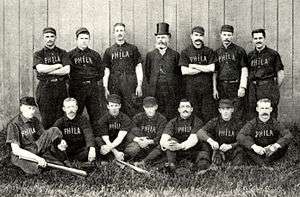
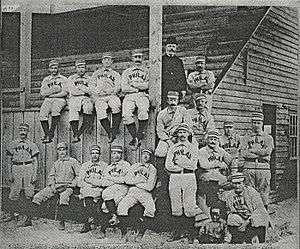
_(LOC).jpg)
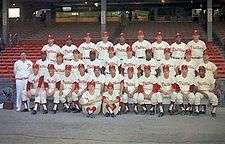
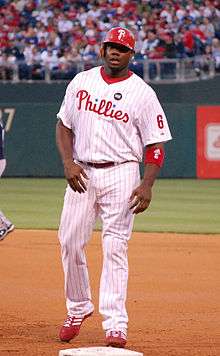
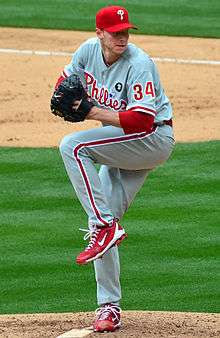
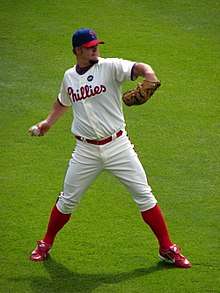
_(cropped).jpg)


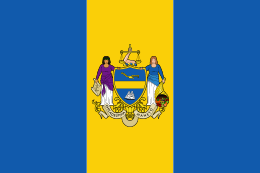

.jpg)